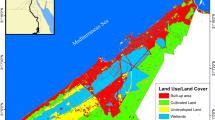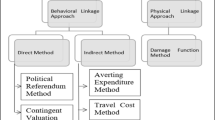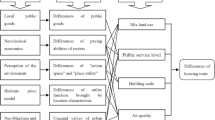Abstract
Due to rapid urbanization, automobility, and industrialization, the increasing desire to protect environments and satisfy residents has led to an emphasis on the creation of sustainable urban environments in China. This paper is an empirical study using hedonic price models to examine a comprehensive set of environmental sustainability elements including green space, transit systems, and central business districts (CBDs) and compare their relative importance in Wuhan, China. The results show that among all housing characteristics, environmental sustainability elements had the greatest impacts on house prices. Natural water resources have the most significant positive effects on property values when they are integrated with cultural, tourism, and commercial resources to form natural recreation clusters or areas. Also, home buyers are willing to pay more for housing clusters or subdivisions with proximity to CBDs. In addition, the significant negative effects of light rail on house prices within a 1-mile radius indicate that it has not become an attractive amenity to home buyers, due to combined effects of other neighborhood amenities, little land use diversity, and the fare system. These results have implications for local and regional governments in setting priorities for sustainable development.


Similar content being viewed by others
References
Anderson, A. C. (1970). The effect of rapid transit on property values. Appraisal Journal, 38, 59–68.
Brown, G. M., & Pollakowski, H. O. (1977). Economic valuation of shoreline. Review of Economics and Statistics, 59, 272–278.
Cervero, R. (1998). The transit metropolis: A global inquiry. Washington, DC: Island Press.
Cervero, R., & Duncan, M. (2002). Benefits of proximity to rail on housing markets: Experiences in Santa Clara County. Journal of Public Transportation, 5(1), 1–18.
Cervero, R., & Kockelman, K. M. (1997). Travel demand and the 3 Ds: Density, diversity, and design. Transportation Research D: Transport and Environment, 2(3), 199–219.
Cervero, R., & Murakami, J. (2009). Rail + property development in Hong Kong: Experiences and extensions. Urban Studies, 46(10), 2019–2043.
Chen, W. Y., & Jim, C. Y. (2010). Amenities and disamenities: A hedonic analysis of the heterogeneous urban landscape in Shenzhen (China). The Geographical Journal, 176(3), 227–240.
Chen, H., Rufolo, A., & Dueker, K. (1998). Measuring the impact of light rail systems on single-family home prices: A hedonic approach with GIS application. Transportation Research Record, 1617, 38–43.
CNU. (2010). Charter of the new urbanism for Congress For The New Urbanism. http://www.cnu.org/charter.
Cropper, M. L., Deck, L. B., & McConnell, K. E. (1988). On the choice of functional form for hedonic price functions. Review of Economics and Statistics, 70, 668–675.
Darling, A. H. (1973). Measuring the benefits of urban water parks. Land Economics, 49, 22–34.
Du, N. R., Ottens, H., & Sliuzas, R. (2010). Spatial impact of urban expansion on surface water bodies—A case study of Wuhan, China. Landscape and Urban Planning, 94(3–4), 175–185.
Ferguson, B. G., Goldberg, M. A., & Mark, J. (1988). The pre-service impacts of the Vancouver advanced light rail transit system on single family property values. In J. M. Clapp & S. Messner (Eds.), Real estate market analysis: Methods and applications (pp. 78–110). New York, NY: Praeger.
Friedmann, J. (2005). China’s urban transition. Minneapolis: University of Minnesota Press.
Goodman, A. C. (1989). Topics in empirical urban housing research. In R. F. Muth & A. C. Goodman (Eds.), The economics of housing markets (pp. 49–146). New York, NY: Harwood Academic.
Hao, Q., & Chen, J. (2007). Distance to CBD, transportation accessibility and the spatial differences of residential housing prices in Shanghai. World Economic Papers (Shijie Jingji Wenhui), (1), 22–35.
Hartig, T., Evans, G. W., Jamner, L. D., Davis, D. S., & Garling, T. (2003). Tracking restoration in natural and urban field settings. Journal of Environmental Psychology, 23, 109–123.
Heikkila, E., Gordon, P., Kim, J. I., Peiser, R. B., Richardson, H. W., & Dale-Johnson, D. (1989). What happened to the CBD-distance gradient?: Land values in a policentric city. Environment and Planning A, 21(2), 221–232.
Hess, D. B., & Almeida, T. M. (2007). Impact of proximity to light rail rapid transit on station-area property values in Buffalo, New York. Urban Studies, 44(5/6), 1041–1068.
Hoch, I., & Waddell, P. (1993). Apartment rents: Another challenge to the monocentric city model. Geographical Analysis, 25, 20–34.
Huh, S., & Kwak, S. J. (1997). The choice of functional form and variables in the hedonic price model in Seoul. Urban Studies, 34(7), 989–998.
Hui, E. C. M., Chau, C. K., Pun, L., & Law, M. Y. (2007). Measuring the neighboring and environmental effects on residential property value: Using spatial weighting matrix. Building and Environment, 42(6), 2333–2343.
Jiao, L. M., & Liu, Y. L. (2010). Geographic field model based hedonic valuation of urban open spaces in Wuhan, China. Landscape and Urban Planning, 98(1), 47–55.
Jim, C. Y., & Chen, W. Y. (2006). Impacts of urban environmental elements on residential housing prices in Guangzhou (China). Landscape and Urban Planning, 78(4), 422–434.
Jim, C. Y., & Chen, W. Y. (2007). Consumption preferences and environmental externalities: A hedonic analysis of the housing market in Guangzhou. Geoforum, 38(2), 414–431.
Kain, J. F., & Quigley, J. M. (1970). Evaluating the quality of the residential environment. Environment and Planning, 2(1), 23–32.
Kong, F. H., Yin, H. W., & Nakagoshi, N. (2007). Using GIS and landscape metrics in the hedonic price modeling of the amenity value of urban green space: A case study in Jinan City, China. Landscape and Urban Planning, 79(3–4), 240–252.
Li, L. M. (2005). Wuhanshi Qinggui Yunying Xianzhuang Fenxi [The current operation and management of Wuhan light rail line]. Guidao Jiaotong [Traffic and Transportation], 5, 9–10.
Li, H. (2008). A study on the analysis of dynamic change landscape structure and driving forces of lake and river wetland of Wuhan. Master’s Degree Thesis, Huazhong Agricultural University (in Chinese).
Li, F., Wang, R. S., Paulussen, J., & Liu, X. S. (2005). Comprehensive concept planning of urban greening based on ecological principles: A case study in Beijing, China. Landscape and Urban Planning, 72(4), 325–336.
Li, S. M., & Wu, F. L. (2004). Contextualizing residential mobility and housing choice: Evidence from urban China. Environment and Planning A, 36(1), 1–6.
Li, X. M., Xiao, R. B., Yuan, S. H., Chen, J. A., & Zhou, J. X. (2010). Urban total ecological footprint forecasting by using radial basis function neural network: A case study of Wuhan city, China. Ecological Indicators, 10, 241–248.
Li, Z. S., Zhang, G. Q., Li, D. M., Zhou, J., Li, L. J., & Li, L. X. (2007). Application and development of solar energy in building industry and its prospects in China. Energy Policy, 35, 4121–4127.
Ling, Z., & Hui, E. C. M. (2013). Structural change in housing submarkets in burgeoning real estate market: A case of Hangzhou, China. Habitat International, 39, 214–223.
Loo, B. P. Y., & Li, D. Y. N. (2006). Developing metro systems in the People’s Republic of China: Policy and gaps. Transportation, 33, 115–132.
McLeod, P. B. (1984). The demand for local amenity: A hedonic price analysis. Environment and Planning A, 16, 359–400.
Nelson, A. C. (1992). Effects of elevated heavy-rail transit stations on house prices with respect to neighborhood income. Transportation Research Record, 1359, 127–132.
Osland, L., & Thorsen, I. (2008). Effects on housing prices of urban attraction and labor-market accessibility. Environment and Planning A, 40, 2490–2509.
Pan, H. X., & Zhang, M. (2008). Rail transit impacts on land use. Transportation Research Record: Journal of the Transportation Research Board, 2048, 16–25.
PDO. (2010). China’s urban area reaches 32,521 kilometers for People’s Daily Online. http://english.peopledaily.com.cn/200705/14/eng20070514_374430.html.
Pior, M. Y., & Shimizu, E. (2001). GIS-aided evaluation system for infrastructure improvements: Focusing on simple hedonic and Rosen’s two-step approaches. Computers, Environment and Urban Systems, 25, 223–246.
Qin, B., & Han, S. S. (2013). Emerging polycentricity in Beijing: Evidence from housing price variations 2001-05. Urban Studies, 50(10), 2006–2023.
Rosen, S. (1974). Hedonic prices and implicit markets: Product differentiation in pure competition. Journal of Political Economy, 82(1), 35–55.
Ryan, S. (1999). Property values and transportation facilities: Finding the transportation-land use connection. Journal of Planning Literature, 13(4), 412–427.
Schrijnen, P. M. (2000). Infrastructure networks and red-green patterns in city regions. Landscape and Urban Planning, 48, 191–204.
So, H. M., Tse, R. Y. C., & Ganesan, S. (1996). Estimating the influence of transport on house prices: Evidence from Hong Kong. Journal of Property Valuation and Investment, 15(1), 40–47.
Song, Y., & Knaap, G.-J. (2003). New urbanism and housing values: A disaggregate assessment. Journal of Urban Economics, 54(2), 218–238.
SSB. (2009). Zhongguo Tongji Nianjian [China statistical yearbook] State Statistical Bureau. Beijing: China Statistics Press.
Stokols, D., Grzywacz, J. G., McMahan, S., & Phillips, K. (2003). Increasing the health promotive capacity of human environments. American Journal of Health Promotion, 18, 4–13.
Tian, L. (2006). Impacts of transport projects on residential property values in China: Evidence from two projects in Guangzhou. Journal of Property Research, 23(4), 347–365.
WATPD. (2006). Wuhan Jiaotong Niandu Fazhan Baogao [Wuhan annual development report on transportation]. Wuhan: Wuhan Academy of Transportation Planning and Design.
Wen, H. Z., Jia, S. H., & Guo, X. Y. (2005). Hedonic price analysis of urban housing: An empirical research on Hangzhou, China. Journal of Zhejiang University SCIENCE, 6A(8), 907–914.
Williams, A. (1991). A guide to valuing transport externalities by hedonic means. Transport Review, 11(4), 311–324.
Wong, T. C. (2008). Integrated resort in the central business district of Singapore: The land use planning and sustainability issues. In T. C. Wong, B. Yuen, & C. Goldblum (Eds.), Spatial planning for a sustainable Singapore (pp. 59–78). Berlin: Springer.
WUPB. (2008). Cheng Xiang Gui Hua Dong Tai (Urban Planning Newsletter). Wuhan Urban Planning Bureau, 20(8) (in Chinese).
Wu, J., & Xie, H. (2011). Evolution characteristics of Wuhan lakeshore land utilization in urbanization process. Advanced Materials Research, 224, 185–191.
Wuhan Almanac. (2008). Wuhan Almanac Publisher, Wuhan.
Yang, P.-J. (2005). From central business district to new downtown: Designing future sustainable urban forms in Singapore. In M. Jenks & N. Dempsey (Eds.), Future forms and design for sustainable cities (pp. 167–184). Jordan Hill: Architectural Press.
Yin, Z. (2005). Development of solar thermal systems in China. Solar Energy Material & Solar Cells, 86, 427–442.
Zeng, Z. P., & Lu, X. H. (2008). Spatial-temporal evolution of urban lakes in Wuhan City based on remote sensing images. Journal of Lake Sciences, 20(5), 648–654. (in Chinese).
Zhang, M. (2007). China edition of transit-oriented development. Transportation Research Record: Journal of the Transportation Research Board, 2038, 120–127.
Zhang, X. L., Shen, L. Y., & Wu, Y. Z. (2011). Green strategy for gaining competitive advantage in housing development: A China study. Journal of Cleaner Production, 19, 157–167.
Zhang, M., & Wang, L. L. (2013). The impacts of mass transit on land development in China: The case of Beijing. Research in Transportation Economics, 40, 124–133.
Zhang, K. M., & Wen, Z. G. (2008). Review and challenges of policies of environmental protection and sustainable development in China. Journal of Environmental Management, 88, 1249–1261.
Zheng, S. Q., & Kahn, M. E. (2008). Land and residential property markets in a booming economy: New evidence from Beijing. Journal of Urban Economics, 63, 743–757.
Acknowledgments
We acknowledge the financial support from the Mark Diamond Research Fund, University at Buffalo, The State University of New York (Grant No. F-07-09). We would like to thank three anonymous reviewers for their helpful comments and suggestions.
Author information
Authors and Affiliations
Corresponding author
Rights and permissions
About this article
Cite this article
Huang, H., Yin, L. Creating sustainable urban built environments: An application of hedonic house price models in Wuhan, China. J Hous and the Built Environ 30, 219–235 (2015). https://doi.org/10.1007/s10901-014-9403-8
Received:
Accepted:
Published:
Issue Date:
DOI: https://doi.org/10.1007/s10901-014-9403-8




